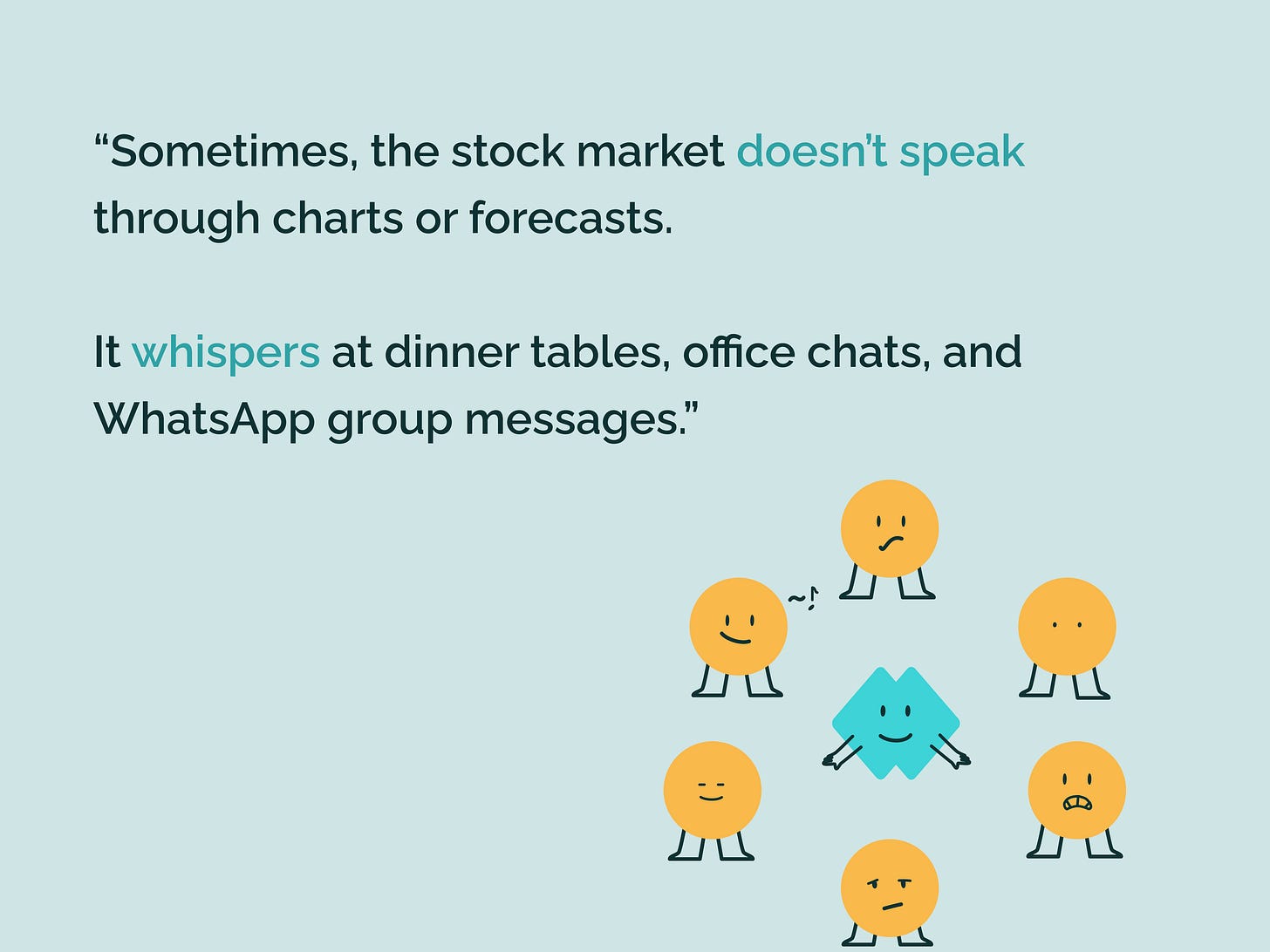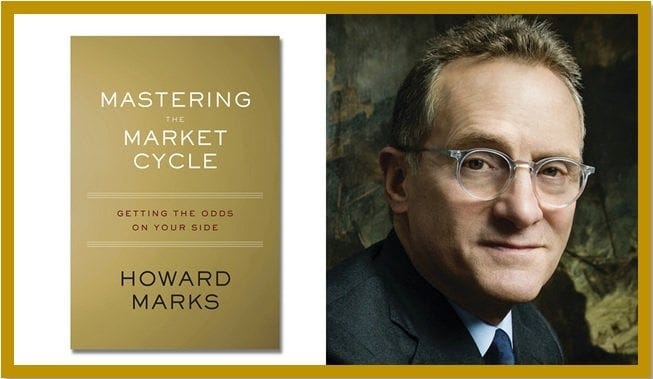Hi 👋 welcome to Recompound Blog - The Investment Mindshift. We help you better your mindset on investment and economics one article at a time. More: Our Values | Advisory | Get to know us | Picks
The polls in the previous week requested a stock deep dive. But we are writing a deep dive for paid subscribers as there is no free lunch. So don’t forget to upgrade your subscription plan if you have not already *wink*. As a disclaimer, the deep dive is by no means to be interpreted as investment advice. It is written solely for educational purposes and you should do your own research or consult your investment advisor before making any investment decisions.
You don’t need to be a professional investor to sense where the market might be heading—sometimes, it’s as simple as listening.
The Cocktail Party Theory: What People Say Matters
Peter Lynch, one of the most successful investors of all time, managed the Magellan Fund at Fidelity from 1977 to 1990, delivering an astounding average return of 29% per year. Under his leadership, the fund grew from $18 million to $14 billion, making him a legend in the investment world.
But Lynch’s greatest insights weren’t just for Wall Street. He believed that everyday observations and conversations could offer powerful clues about market trends. One of his most famous ideas is what he called the “cocktail party theory.”
In his book One Up on Wall Street, Lynch explains:
*“If the professional economists can’t predict economies and professional forecasters can’t predict markets, then what chance does the amateur investor have? You know the answer already, which brings me to my own ‘cocktail party’ theory of market forecasting, developed over the years of standing in the middle of living rooms, near punch bowls, listening to what the nearest ten people said about stocks.”
Beating the Street - 1993*
He describes four stages:
Stage 1: No one wants to talk about stocks. If you mention you manage a mutual fund, they quickly change the subject.
Stage 2: People acknowledge your profession but caution you about the risks of investing.
Stage 3: Attendees seek your advice on what stocks to buy.
Stage 4: Everyone, including the dentist, is giving you stock tips.
This progression reflects how market sentiment shifts from skepticism to euphoria, often signaling where we are in the market cycle.
Why News Headlines Often Mislead
Howard Marks, co-founder of Oaktree Capital Management, a firm managing over $170 billion, shares a similar perspective. Marks is known for his sharp insights on risk and market cycles. His investor memos are so respected that even Warren Buffett reads them carefully.
In his book Mastering the Market Cycle, Marks argues that many investors try (and fail) to navigate markets by reacting to economic news headlines.
Marks writes:
“The future isn’t knowable, and macro forecasts are rarely useful.”
The Most Important Thing: Uncommon Sense for the Thoughtful Investor - 2011
News reports often describe what just happened, not what’s about to happen. But markets are forward-looking. Investors don’t wait for the news—they try to price it in early.
Think about it: if headlines were a reliable signal, wouldn’t it be easy to make money in markets? In reality, waiting for “good news” often means you miss the opportunity that came when everyone was fearful.
That’s why both Marks and Lynch recommend watching crowd behavior—not just reacting to what’s in the news.
Market moves on emotions
Here’s something beginners often miss: the market doesn’t just move on facts—it moves on emotions. Why? Because decision to buy and sell always use emotions.
That’s precisely why understanding crowd behavior is important. When everyone is excited and rushing to buy, prices might already be too high. When everyone is scared and selling, prices might already be low.
In investing, sometimes the best opportunities come from doing the opposite of the crowd—buying when others are fearful, and being cautious when others are euphoric.
But it’s not just about buying “cheap stocks.” It’s about recognizing that when prices fall because of fear, you might be able to buy a great business at a bargain. Think of it like getting your favorite iPhone 16 Pro Max — but on a massive sale.
When prices are low, you have the chance to own profitable, high-quality companies at a fraction of their real value. But when prices are high, driven by hype and excitement, you might end up paying too much for the same business, reducing or even damaging your potential returns.
That’s why watching the crowd matters:
When everyone is fearful and selling, they might be pushing prices lower than what a company is truly worth.
When everyone is excited and buying, they might be driving prices higher than what the company is realistically worth.
By observing the mood and being aware of these patterns, you can avoid buying into hype—and instead position yourself to buy strong companies when they’re undervalued, not overpriced.
Just recently in April 2025, we saw a textbook example in Indonesia:
On April 8, markets were rattled when former U.S. President Donald Trump announced new tariffs on Asian imports, sparking fears of a renewed trade war. The news triggered panic across emerging markets—Indonesia’s IHSG dropped sharply and even experienced a trading halt.
But here’s what’s remarkable: that day of extreme fear marked the bottom.
From that low point, the Indonesian market went on to rebound 18% in the following weeks.
It was a classic case of a headline-induced panic bottom—proving once again that emotions often peak just as opportunity reappears.
Thought exercise: What are people around you saying now?
In the past year, Indonesia has faced plenty of challenges: global economic slowdowns, falling commodity prices, political uncertainties, layoffs, distrust towards the government, and investor outflows. The headlines have been overwhelmingly negative.
But Lynch and Marks would both ask: beyond the news, what are people around you saying?
Are your friends staying dead silent or excitedly swapping stock tips ?
At work, are colleagues “waiting for things to get better” or actively talking about new investment opportunities ?
Is the stock market barely mentioned — or a hot topic in WhatsApp group chats ?
If Peter Lynch were standing next to you, listening in, what would he hear?
And how might Howard Marks interpret those conversations?
I’ll leave you with this question:
Based on the mood you’re observing—whether in Indonesian stocks, U.S. markets, or even Crypto—what stage of the cycle do you think we’re in? What kind of behavior or sentiment are you noticing around you?
Stop reacting to news headlines.
Understanding the market cycle through the crowd might not only save you money… it could make you a LOT of it.
But here’s the catch. How do I know if a company is undervalued?
I am quite sure after reading the above, you would have the following conclusion:
Watching people is easy, I can do that
Knowing that there are plenty of opportunities in the market is easy, I can also do that
But how on earth do I know the fair value of the company? And how do I know that the company is sold at a discount akin to a 10.10, 11.11 or 12.12 at Shopee?
Let’s start with a toy example, which aims to be really simple illustration.
First of all, a company is of any value, because it makes money from its sales activities. Let’s say, a company sells IPhones to consumers and is making 100 every year in net profits. Meaning that considering all costs, taxes, depreciation, etc, the company makes 100.
That company who’s making 100 every year is valuable to its shareholders. Let’s say Toby owns 55% of that company and Budi owns 45% of that company. That 100, can be distributed to Toby and Budi every year, them getting 55 and 45 each respectively.
Now let’s say Wilson enters the picture and he wants to purchase the entire company from Toby and Budi. If Wilson agrees to pay 1,000 do you think he is overpaying?
On the other hand, if Toby and Budi agrees to sell at 100, do you think that Toby and Budi are underselling?
Well, if Wilson thinks that the company is super likely to be able to sell iPhones in 5 years to come, making 100 each year, he would be overpaying if he buys the company for 1,000. For 100, he would be getting the company at a bargain. How much bargain? 80% (500 - 100 / 500).
So from this example, you could already get the drift.
Let’s map this toy example into a real publicly listed company that people could buy
Is Blue Bird Tbk undervalued or overvalued?
Blue Bird is the largest taxi company in Indonesia with about 24,000 units and it is distributing healthy amounts of dividends (yield is roughly 5%).
Yet if you take a cursory look of its share price, it has dropped rather significantly (-76.28%) from it’s IPO price.
Does that mean that you get a 76.28% discount from its fair value? Let’s dive right in.







